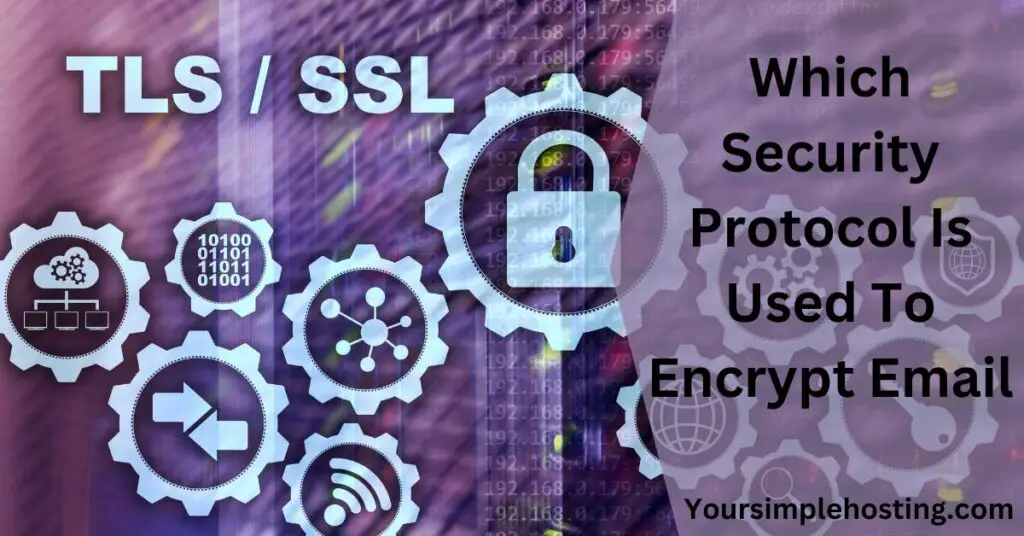Email encryption is critical in online communication, ensuring the privacy and security of sensitive information exchanged electronically.
With the increasing number of cyber threats, it’s essential to understand the different security protocols used to encrypt emails and protect the confidentiality of your data.
This article will delve into the most commonly used security protocols for email encryption and help you determine which one best fits your specific needs.
Whether you’re a user concerned about privacy or a business looking to secure sensitive data, this article will provide the necessary knowledge to make well-informed decisions about email encryption.

Table of Contents
Why Are Email Security Protocols Important?
Email security protocols matter for several reasons, including:
1. Protecting Sensitive Information
Emails are commonly used to exchange sensitive information, such as financial information, personal details, and confidential business information.
Without encryption, unauthorized parties can intercept and access this information, resulting in serious consequences, such as identity theft or compromising confidential business information.
2. Compliance With Regulations
Many industries, such as healthcare and finance, are subject to regulations requiring sensitive information protection. Email encryption is often a requirement to meet these regulations and ensure compliance.
3. Maintaining Privacy
Encrypting emails protects the privacy of both the sender and the recipient, ensuring that the contents of emails remain confidential and cannot be accessed by unauthorized parties.
4. Preventing Data Breaches
Email is one of the primary vectors of cyberattacks, and unencrypted emails can be easily intercepted and exploited. Organizations can prevent data breaches and protect sensitive information from being stolen by encrypting emails.
5. Protecting Intellectual Property
Email is commonly used to exchange confidential business information, such as trade secrets, patents, and research and development data.
Email security protocols can protect intellectual property and prevent unauthorized parties from accessing this information.
In conclusion, email security protocols are essential for protecting sensitive information, maintaining privacy, preventing data breaches, and ensuring compliance with regulations. Individuals and organizations can protect their confidential information by encrypting email communications.
Which Security Protocol Is Used To Encrypt Email?
Here’s a list of popular email security protocols:
S/MIME (Secure/Multipurpose Internet Mail Extensions)
S/MIME is a widely used protocol for encrypting emails, providing encryption and digital signature capabilities.
It uses public-key cryptography to secure email communications and is supported by many email clients, including Microsoft Outlook and Apple Mail. S/MIME encryption is transparent to the end user and operates at the application layer, assuring end-to-end encryption.
PGP (Pretty Good Privacy)
PGP is another popular yet straightforward mail transfer protocol for encrypting emails. It’s known for its strong encryption algorithms and ease of use.
It uses a combination of public-key and symmetric-key cryptography to secure email communications and can be used with various email clients, including Thunderbird and Apple Mail.
PGP provides users with a high degree of security and privacy, making it an excellent option for individuals and organizations concerned about email security.
TLS (Transport Layer Security)
TLS is a protocol used to secure internet communications, including email. It operates at the transport layer and encrypts the email message, including the header and attachments.
It is used by many email servers to encrypt email in transit and can be enabled in most email clients.
Transport Layer Security is a great option for organizations looking to secure their email communications, as it provides a secure connection between the server and client.
SSL (Secure Sockets Layer)
SSL is an outdated protocol that TLS has largely replaced.
However, it’s still in use and provides a secure connection between the email server and the client. SSL operates at the transport layer and encrypts the email message, including the header and attachments.
Therefore, when choosing a security protocol for encrypting email messages, it’s essential to consider the level of security required, the ease of use, and compatibility with your email client.
Whether you’re an individual or an organization, choosing a simple mail transfer protocol can ensure the privacy and security of your email communications.

How To Choose the Right Security Protocol for Encryption?
When choosing the right security protocol to encrypt email, there’s a list of key factors to consider, such as the following:
Level of Security Required
Different security protocols offer varying levels of security, so choosing one that meets your specific needs is crucial. For example, a business handling sensitive information may require a protocol with strong encryption, such as PGP or S/MIME.
Compatibility
Verify that the security protocol you choose is compatible with your email client and the email clients of your correspondents; this will guarantee that encrypted emails can be securely transmitted and received.
Ease of Use
Some security protocols are easier to use than others, and choosing one you and your correspondents can easily use is essential.
For example, S/MIME is transparent to the end-user and operates at the application layer, making it an excellent option for those who don’t want to be bogged down by technical details.
Key Management
Consider the ease of key management when choosing a security protocol. For example, some protocols, such as S/MIME, use digital certificates issued by a trusted third party, while others, such as PGP, use a public and private key generated by the user.
Cost
Some security protocols, such as S/MIME, may require a certificate fee, while others, such as PGP, are free.
Consider the cost when choosing a security protocol and ensure it fits your budget.
When choosing the right security protocol to encrypt email, it’s essential to consider your specific needs, including the level of security required, compatibility, ease of use, key management, and cost.
These factors can help you choose the best security protocol for email encryption.
Conclusion
Email encryption is essential to online communication, providing the privacy and security of sensitive information exchanged electronically.
With the increasing number of cyber threats, it’s crucial to understand the different security protocols used to encrypt emails.
The protocols discussed in this article, including S/MIME, PGP, TLS, and SSL, provide different levels of security and ease of use, and it’s essential to choose the one that meets your specific needs.
Consider compatibility, ease of use, key management, and cost when picking a security protocol. Then, hopefully, you will be able to make a well-informed decision with the help of this article.

Leave a Reply